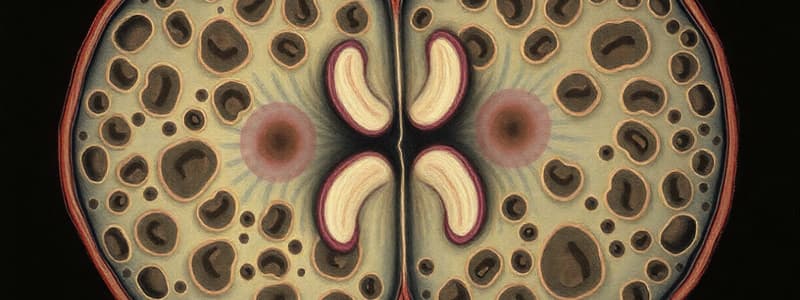Podcast
Questions and Answers
What is the primary function of apoptosis during embryogenesis?
What is the primary function of apoptosis during embryogenesis?
- To strengthen tissue structure
- To promote cell division
- To eliminate excess cells (correct)
- To increase cell size for growth
What condition results from excessive apoptosis in tissues?
What condition results from excessive apoptosis in tissues?
- Atherosclerosis
- Tumor growth
- Neurodegeneration (correct)
- Hyperplasia
What role does apoptosis play in adults?
What role does apoptosis play in adults?
- It prevents any form of cell death
- It is only involved in cancer prevention
- It solely enhances cell multiplication
- It contributes to tissue remodeling by eliminating unneeded cells (correct)
What is a consequence of insufficient apoptosis in tissues?
What is a consequence of insufficient apoptosis in tissues?
During which physiological phase does apoptosis contribute to the involution of the mammary gland?
During which physiological phase does apoptosis contribute to the involution of the mammary gland?
What occurs during the S phase of the cell cycle?
What occurs during the S phase of the cell cycle?
During which phase of the cell cycle does the cell perform most of its normal physiological functions?
During which phase of the cell cycle does the cell perform most of its normal physiological functions?
Which of the following best describes mitosis?
Which of the following best describes mitosis?
What is the primary role of checkpoints in the cell cycle?
What is the primary role of checkpoints in the cell cycle?
Which type of reproduction leads to genetically identical daughter cells?
Which type of reproduction leads to genetically identical daughter cells?
What triggers the start of the cell division process?
What triggers the start of the cell division process?
What is a unique feature of meiosis compared to mitosis?
What is a unique feature of meiosis compared to mitosis?
What happens to the DNA during binary fission in prokaryotes?
What happens to the DNA during binary fission in prokaryotes?
During which phase of the cell cycle does DNA replication occur?
During which phase of the cell cycle does DNA replication occur?
Which phase of the cell cycle is known as the primary growth phase?
Which phase of the cell cycle is known as the primary growth phase?
What characterizes apoptosis?
What characterizes apoptosis?
What does the term 'karyokinesis' refer to?
What does the term 'karyokinesis' refer to?
In which stage of mitosis do the chromosomes align at the cell's equator?
In which stage of mitosis do the chromosomes align at the cell's equator?
Which of the following structures is synthesized during the G2 phase to prepare for cell division?
Which of the following structures is synthesized during the G2 phase to prepare for cell division?
Which type of cells typically do not undergo mitosis?
Which type of cells typically do not undergo mitosis?
What happens during the Anaphase stage of mitosis?
What happens during the Anaphase stage of mitosis?
What occurs during telophase of mitosis?
What occurs during telophase of mitosis?
What is the main role of cytokinesis?
What is the main role of cytokinesis?
What structure aids in forming the cleavage furrow during cytokinesis in animal cells?
What structure aids in forming the cleavage furrow during cytokinesis in animal cells?
Which of the following molecules are involved in the regulation of the cell cycle?
Which of the following molecules are involved in the regulation of the cell cycle?
What is the function of the checkpoints in the cell cycle?
What is the function of the checkpoints in the cell cycle?
During which phase of the cell cycle does chromatin condense into chromosomes?
During which phase of the cell cycle does chromatin condense into chromosomes?
What happens to the nucleolus during telophase?
What happens to the nucleolus during telophase?
What is the outcome of uncontrolled cell division?
What is the outcome of uncontrolled cell division?
What is the primary function of the G1 checkpoint in the cell cycle?
What is the primary function of the G1 checkpoint in the cell cycle?
Which checkpoint is responsible for ensuring that the cell is ready to complete cell division?
Which checkpoint is responsible for ensuring that the cell is ready to complete cell division?
What outcome results from a loss of control in the cell cycle?
What outcome results from a loss of control in the cell cycle?
How does a defective p53 gene affect a cell's response to the cell cycle?
How does a defective p53 gene affect a cell's response to the cell cycle?
What is a key difference between normal cells and cancer cells regarding DNA replication?
What is a key difference between normal cells and cancer cells regarding DNA replication?
Which statement best describes necrosis?
Which statement best describes necrosis?
In the context of cancer, what role does the p53 protein play during the cell cycle?
In the context of cancer, what role does the p53 protein play during the cell cycle?
What happens to cell communication in cancer cells compared to normal cells?
What happens to cell communication in cancer cells compared to normal cells?
Flashcards are hidden until you start studying
Study Notes
Introduction
- Organisms need new cells for growth, replacement, and repair.
- New cells are formed through asexual reproduction, where one cell divides into two identical cells (e.g., mitosis and binary fission)
- Sexual reproduction involves the joining of two cells (e.g., egg and sperm) to create a new cell (zygote).
Cell Division
- Prokaryotes: Division occurs through binary fission.
- Prokaryotes have a single circular DNA molecule.
- DNA replicates, and each copy attaches to the cell membrane.
- The cell pulls apart, separating the DNA copies.
- Two identical daughter cells are formed.
- Eukaryotes: Division occurs when the cell reaches a certain size and energy stores are sufficient.
- The process is controlled by the cell cycle.
The Cell Cycle
- The cell cycle represents the stages a cell goes through from division to the next division.
- It consists of three phases:
- Interphase: The period between cell divisions, where the cell grows and copies its DNA.
- Mitosis: Nuclear division, where the replicated chromosomes are separated into two daughter nuclei.
- Cytokinesis: The division of the cytoplasm, resulting in two daughter cells.
Interphase
- G1 (Growth 1) Phase:
- Cell grows and increases organelle production.
- Prepares for DNA replication.
- S (Synthesis) Phase:
- DNA amount is doubled.
- Chromosomes are replicated to form sister chromatids.
- G2 (Growth 2) Phase:
- Cell continues to grow and produce proteins and organelles needed for cell division.
- Prepares for mitosis.
Mitosis
- Nuclear division that occurs in eukaryotes.
- Consists of four phases:
- Prophase:
- Chromatin condenses into chromosomes.
- Nucleolus and nuclear membrane disappear.
- Mitotic spindle forms from centrioles.
- Metaphase:
- Chromosomes align at the cell equator.
- Centromeres are attached to kinetochore fibers.
- Anaphase:
- Sister chromatids are pulled apart by spindle fibers.
- Each pole receives a complete set of original genes.
- Telophase:
- Chromosomes reappear as chromatin.
- Nuclear envelope reforms around each set of chromosomes.
- Nucleolus becomes visible.
- Spindle breaks apart.
- Prophase:
Cytokinesis
- The division of the cytoplasm.
- Involves the formation of a cleavage furrow in animal cells.
- Acts to separate the daughter cells after mitosis.
Regulation of the Cell Cycle
- Aims to prevent uncontrolled cell division.
- Controlled by cyclins and cyclin-dependent kinases (CDKs).
- They form heterodimers that activate or deactivate target proteins.
- Checkpoints: Monitor and regulate the cell cycle to ensure proper progression.
- G1 Checkpoint: Ensures cell is ready for DNA replication.
- G2 Checkpoint: Ensures cell is ready for mitosis.
- Metaphase Checkpoint: Ensures all chromosomes are attached to spindle fibers before anaphase.
Uncontrolled Cell Division
- Uncontrolled cell division leads to tumor formation.
- Defective p53 gene can cause loss of cell cycle control.
- Cancer cells lack p53 function, leading to uncontrolled growth and multiplication.
Cell Death
- Necrosis:
- Unregulated cell death due to injury, disease, or blood supply failure.
- Apoptosis:
- Programmed cell death, a regulated process for removing unwanted cells.
Necrosis vs Apoptosis
- Necrosis:
- Uncontrolled cell death.
- Causes cell swelling and lysis.
- Can damage surrounding tissues.
- Apoptosis:
- Controlled cell death.
- Involves cell shrinkage and fragmentation.
- Minimizes damage to surrounding tissues.
Apoptosis in Physiological Situations
- Important for embryogenesis, morphogenesis, and tissue remodeling.
Apoptosis in Adults
- Plays a role in tissue remodeling and hormone-regulated processes.
Apoptosis in Disease
- Too much apoptosis: Tissue atrophy, neurodegeneration.
- Too little apoptosis: Hyperplasia, atherosclerosis.
Why Cell Division is Important
- Cell division allows for growth and repair, enabling organisms to maintain their size and function.
- Cell division is more efficient than cell enlargement for maintaining cellular function.
- Larger cells have a lower surface area to volume ratio, making it difficult for nutrients and wastes to be exchanged efficiently.
- Cell division maintains a more optimal surface area to volume ratio, ensuring efficient function.
Studying That Suits You
Use AI to generate personalized quizzes and flashcards to suit your learning preferences.



